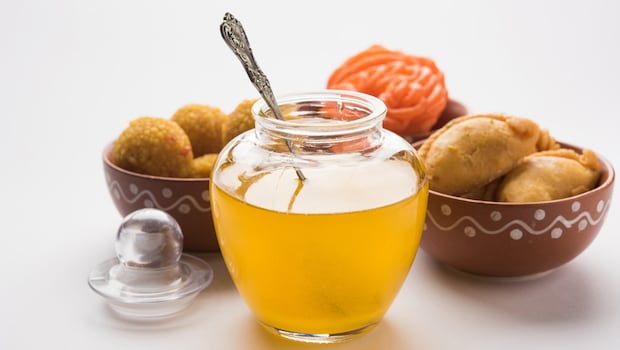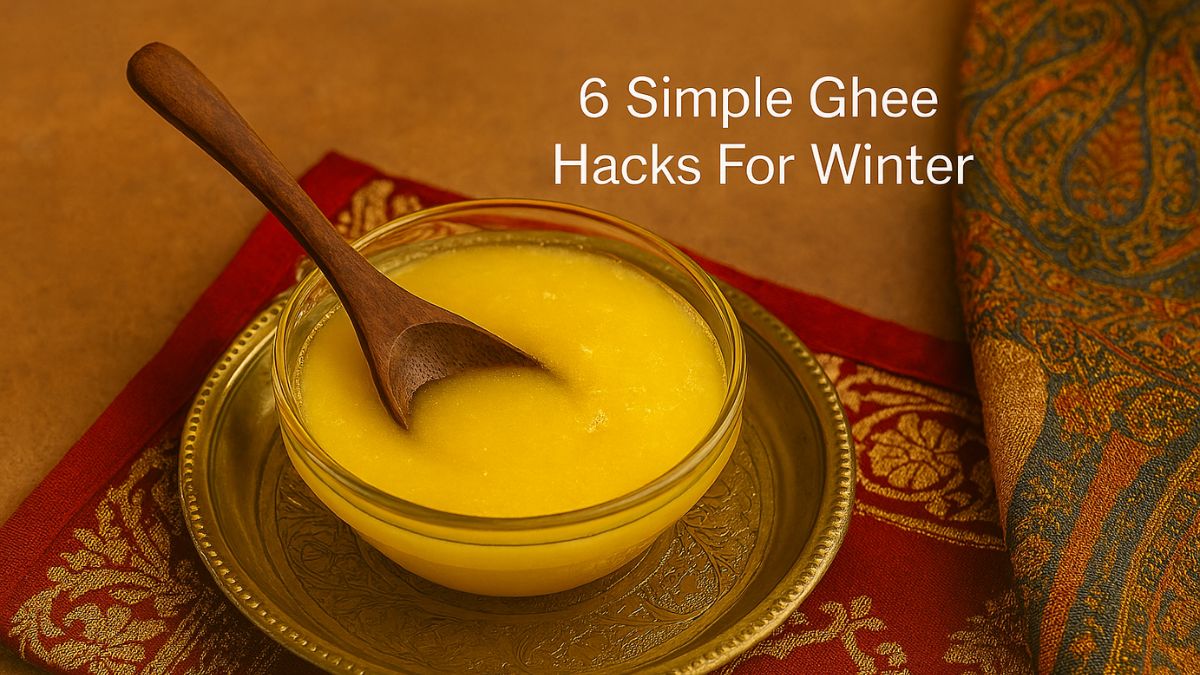If there is one ingredient that defines Indian cooking through winter, it is ghee. We put it on our rotis, melt it over dal, stir it into khichdi and even add it to laddoos. But as soon as the temperature drops, ghee begins to firm up, turning into a hard block that refuses to break down. Scooping it becomes a workout and melting it repeatedly can affect its aroma and texture. That is why many home cooks look for simple, safe and fuss-free ways to keep their ghee semi-liquid through the colder months. Before we get into easy winter hacks, it helps to understand why ghee solidifies in the first place and how you can store homemade ghee properly for a longer shelf life.
Also Read: Stainless Steel vs Glass Electric Kettles: Which One Fits Your Kitchen Best?
Why Does Ghee Solidify In Winter?

Ghee is packed with saturated fats, which naturally harden when temperatures fall. In winter, the temperature drops to 10-15 degrees, which causes the fat molecules in ghee to crystallize and form a firm layer. This is completely normal and does not mean spoilage. The texture changes purely due to temperature, not quality. Once the environment becomes warmer, ghee automatically softens and returns to its smooth, glossy state.
Here Are 6 Hacks To Keep Your Ghee Easy To Scoop In Winter
1. Keep Your Ghee Jar Near Naturally Warm Zones In The Kitchen

One of the easiest winter hacks is to store your ghee where the kitchen stays warm on its own. Placing the jar on the shelf closest to the hob helps maintain a soft, semi-liquid consistency because the area receives mild heat whenever you cook. This prevents the fats from crystallising fully. You must, however, ensure it is not placed too close to direct flame. The aim is gentle warmth, not heat exposure, which can affect flavour.
2. Add A Teaspoon Of Oils With Lower Melting Points
A small amount of mustard oil blended into ghee can keep it from turning rock solid. This oil stays fluid even in winter, which helps maintain a smoother consistency. Add one teaspoon per cup of ghee and mix well. The flavour remains almost unchanged, especially if you choose cold-pressed oils.
3. Use A Wide-Mouth Glass Jar Instead Of Deep Containers

Storing ghee in a wide-mouth jar allows even mild room temperature to soften its surface quickly. Deep jars freeze into narrow tunnels that are difficult to access with a spoon. A broad container also reduces the time needed for the top layer to liquefy naturally. Wide jars are easier to clean, reduce the chance of moisture entering and make daily scooping more convenient. This simple switch can make a noticeable difference in winter.
4. Place The Jar In Lukewarm Water For A Few Minutes
If your ghee has already solidified, avoid microwaving it directly because high heat can alter its aroma. Instead, place the closed jar in a bowl of lukewarm water. The gentle warmth slowly loosens the surface and melts only the upper layer, making scooping effortless. This method is safe for both homemade and store-bought ghee, and it preserves nutritional value better than repeated heating. It is also a quick fix when you are in a hurry.
5. Warm Your Spoon Before Scooping

This simple everyday trick works beautifully. Dip your spoon in hot water for a few seconds, wipe it dry, and then scoop the ghee. The warm metal melts just enough of the top layer to help you slide the spoon through without pressure. It is especially useful when cooking early in the morning when the kitchen is still cold. It avoids any reheating of the ghee itself and keeps the flavour intact.
6. Stir Your Ghee Once A Day During Peak Winter
Regular stirring helps maintain a softer consistency because it prevents the fat crystals from settling into a hard block. Every morning or evening, gently mix the ghee with a dry spoon. This distributes the heat-insulated pockets within the jar and slows solidification. Stirring is particularly effective for homemade ghee, which naturally contains varying fat structures. It keeps the texture creamy and ensures you do not have to struggle while scooping.
Also Read: Stainless Steel vs Glass Electric Kettles: Which One Fits Your Kitchen Best?
How To Store Homemade Ghee For Long Shelf Life

Here are some simple ways to keep your homemade ghee fresh and aromatic for long:
1. Use a Clean, Dry, Airtight Glass Jar: Prevents contamination and preserves freshness.
2. Avoid Moisture: Even a single drop of water can lead to microbial growth and spoilage.
3. Always Use A Dry Spoon: This keeps the ghee free from moisture and bacteria.
4. Store Away From Direct Sunlight: This protects flavour and quality.
5. Avoid Frequent Reheating: Repeated heating of ghee can degrade taste and nutrients.
6. Divide Large Batches Into Smaller Jars: This minimizes exposure to air and extends shelf life.
7. Shelf Life: Properly stored homemade ghee lasts 3–6 months at room temperature.
So, follow these tips to keep your ghee easily scoopable in winter!
About Nikita NikhilMeet Nikita, a passionate soul with an insatiable love for two things in life: Bollywood and food! When she's not indulging in binge-watching sessions, Nikita can be found behind the lens capturing moments or expressing her creativity through painting.








